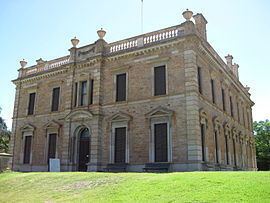Established 1854 Postal code 5415 | Postcode(s) 5415 Founded 1854 Local time Tuesday 2:48 AM | |
 | ||
Population 223 (2006 census) (2006 Census) Weather 13°C, Wind E at 6 km/h, 89% Humidity | ||
Mintaro is an historic town in the eastern Clare Valley, about 128 km north of Adelaide, South Australia. The town lies at the south-eastern corner of the Hundred of Clare, and is pronounced "min-TAIR-oh" by the locals. The entire town of Mintaro was declared a State Heritage Area for South Australia in 1984.
Contents
Map of Mintaro SA 5415, Australia
History
Europeans explored the Mintaro district in mid-1839, firstly John Hill and then Edward John Eyre. The first European settler was pastoralist James Stein who from 1841 held occupation licences for extensive sheep runs stretching from Mount Horrocks through Farrell Flat to the Burra district.
Stein established his homestead on a tributary of the Wakefield River, in a vale beneath Mount Horrocks, about three kilometres west of present Mintaro, naming it Kadlunga, Aboriginal for 'sweet hills' after the abundant honeysuckle there. In following decades, with a succession of owners, Kadlunga Station became a famed sheep and horse stud. The historic stone buildings of the Kadlunga Estate are listed on the Register of the National Estate.
The town was founded in 1854 by Joseph and Henry Gilbert on land purchased by Henry Gilbert in July 1849.
Originally, and for several years, Mintaro was a busy watering stop for throngs of bullock teams travelling the Gulf Road between the copper mining town of Burra and Port Wakefield, transporting copper and coal for the Patent Copper Company.
In mid-1852, as a result of the Victorian Gold Rush, most of these teams and wagons abruptly lay idle for want of teamsters. In desperation the Patent Copper Company imported mule teams from South America and up to a hundred mules were seen to pass though the town each day. The town’s economy collapsed when the teams where rerouted to the new railhead at Gawler from 1857, but soon recovered with the growth of slate quarrying and agricultural production. The town now has tourism as its current primary industry. When the railway from Gawler was later extended through to Burra, the Mintaro railway station was 7 kilometres (4.3 mi) east of the town.
Mintaro features many original Victorian buildings, including Martindale Hall which was used in the 1975 movie Picnic at Hanging Rock, Mintaro Slate Quarries and numerous vineyards and wineries. Due to its rich natural and cultural heritage, Mintaro was the first entire town to be declared a State Heritage Area, in 1984.
Notable Residents
Naming
Although it has been claimed in recent years that the name derives from a Spanish word meaning camp or resting place, based on the presence of South American muleteers in mid-1850s, this connection, though romantic, is incorrect as the first such muleteers did not arrive until 1853. In actual fact, the district was called Mintara in some of the earliest advertisements and the Township of Mintaro name first appeared in an advertisement of 5 November 1849. Other sources have more reliably claimed that the name is derived from the Ngadjuri word mintadloo or Minta - Ngadlu meaning netted water.
Slate and Flagstones
Mintaro’s Cambrian Period slate has a reputation for quality and has been used around the world for the manufacture of billiard tables, monuments, pavements, and many other items. Slate mining began in the 1856, helping to keep the town alive after rerouting of the mule trains. The slate received an honorable menton at the 1868 London International Exhibition and Walter Lindrum, Australian billiards champion, wrote to the quarry with congratulations on the slate’s quality.
Present
Mintaro today is an idyllic, sleepy village, popular as a tourist accommodation destination for visitors to the Clare Valley. It boasts a number of character Bed and Breakfast establishments, and the Magpie & Stump Hotel. There are 2 winery cellar doors in the town, galleries, charming eateries and a Maze.
